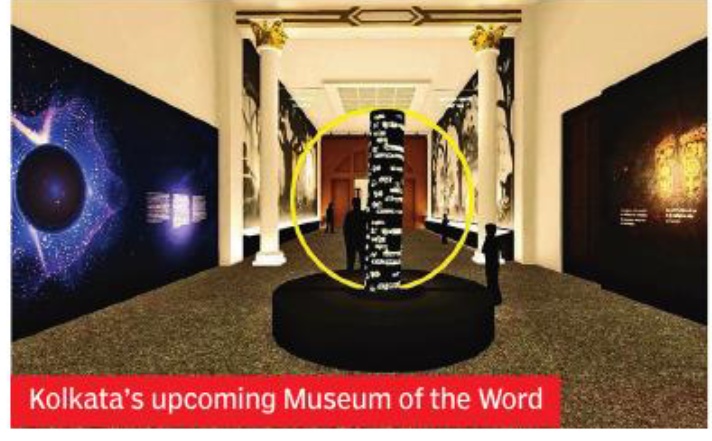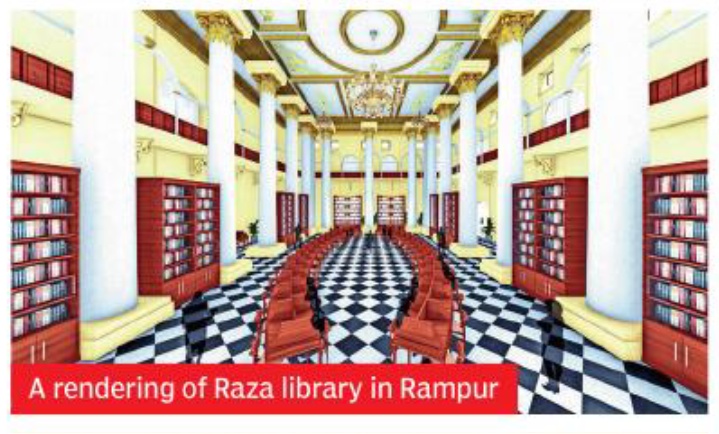Libraries: India
This is a collection of articles archived for the excellence of their content. |
Heritage Libraries
2023
Sneha Bhura, August 6, 2023: The Times of India

From: Sneha Bhura, August 6, 2023: The Times of India

From: Sneha Bhura, August 6, 2023: The Times of India

From: Sneha Bhura, August 6, 2023: The Times of India
In 1774, Rampur’s first nawab Faizulla Khan, who was of a literary bent of mind, decided to house his collection of rare valuable books, manuscripts, and specimens of Islamic calligraphy in the toshakhana (treasure house) of his palace. Once Rampur acceded to the Union of India in 1949, the collection found a permanent home at the opulent Hamid Manzil within the fort-palace complex of the former princely state.
As the Rampur Raza Library prepares for its 250th anniversary celebrations next year, conservation architect Shikha Jain hopes to build a seamless bridge to its origin story as part of a major dome-to-basement restoration project which began in March this year. “The proposal as per the master plan is to join the toshakhana with Hamid Manzil via an open green space. The approach road can lead to either the former treasure chamber or the library, and in between, we hope to build a cafe where people can sit and read,” says Jain, who as, founder-director of the Dronah Foundation, has led more than 60 conservation and museum planning projects.
The Raza Library is just one of India’s many iconic libraries getting a facelift. Some are new museums in heritage buildings such as the upcoming Museum of the Word (Shabdlok) at Kolkata’s Belvedere House, another project that Jain is helming. This museum will trace the evolution of India’s 22 official languages.
Mugdha Sinha, joint secretary in the Union ministry of culture, says there is a new awareness about upgrading historical libraries in India. “We have several historic libraries in India which haven’t been listed or mapped. We badly need a national database on such libraries,” says Jain. But work on other projects is on. The National Mission on Libraries in India, an initiative of the ministry of culture set up in 2013, has taken up several major upgradation and digitisation projects which are now in the process of completion. “It is very important that we are able to upgrade the infrastructure of our libraries, such as microfilming and digitisation of manuscripts, as well as services like Wi-Fi, toilets, cafeterias, etc for researchers,” says Sinha.
In June, Mumbai’s historic David Sassoon Library, established in 1870, reopened to the public after a 16-month restoration initiative helmed by conservation architect Abha Narain Lambah. A multi-party project which included donors like JSW Foundation, ICICI Foundation, Consulate General of Israel, among others, the refurbished structure is a rigorously researched homage to its 19th century Jewish-Indian heritage alongside its Victorian and Art Deco ensembles, complete with antique switches, flooring, lamps and original sloping roofs. India’s largest library by volume and public record is the National Library at the 30-acre Belvedere Estate in Kolkata. The estate originally belonged to Mir Jafar, the puppet nawab of Bengal province in the 18th century, who gifted it to Warren Hastings, the first governor-general of Bengal. Built in the Italian renaissance style, Belvedere House housed the National Library until it was shifted to the newly built Bhasha Bhavan within the same premises in 2004. Urban legends will tell you how the 250-year-old mansion is haunted by Hastings’ ghost. “These are just stories. I have stayed up till 3am at Belvedere House overlooking all the repair work and never encountered a ghost,” laughs Ajay Pratap Singh, director-general at National Library. The launch of the Museum of the Word is slated to happen in the next two months, and Singh assures that it will be “world-class”, sans spirits, of course. The mini-auditorium in the old-annexe building is being spruced up to promote authors and book launches on a no-profit, noloss basis. The left side of Bhasha Bhavan will house a reading cafe while the main reading and lending rooms in the library will embrace the ethos of “community drawing rooms” with comfortable seating. Singh says there is also a new state-of-the-art library coming up at Esplanade 5, a property owned by the National Library which once stocked all its newspaper records. This city-hub library at Esplanade 5 will buy and source books and periodicals. “They say the Library of Congress in Washington DC is the greatest library in the world. We want to make our National Library better than that,” says Singh.
For conservation architects, the challenge is modernising a heritage building while ensuring the original character is not lost. “One should be able to make design interventions in such a way that all mod cons are there,” says Dikshu Kukreja, architect, urban designer and managing principal at CP Kukreja Architects, who has designed many institutional libraries across the country, including the central library at Jawaharlal Nehru University and several IITs like Roorkee and Jodhpur. This year, he has been commissioned to revive the colonial Delhi Public Library built in 1951. Currently in the mapping stage to study the structural stability of the edifice, Kukreja hopes to complete the revival of DPL by early next year.
“Incorporating modern-day requirements of function, comfort, technology while accommodating many more students than the library was originally designed for was a daunting challenge for us too,” says noted architect and urban conservationist Brinda Somaya about the Vikram Sarabhai Library project at IIMA. It went on to win a Unesco award for the way in which it retained the original character of architect Louis Kahn’s modernist vision of geometric circles and arches.
For lack of funds, the Madras Literary Society (MLS), an archival lending library over two centuries old which boasts of Aristotle’s ‘Opera Omnia’ from 1619, has chosen a different approach to restoration. Not only can members pay for restoring a book, they can adopt a piece of furniture. “We have repaired and, restored some 17 pieces of old furniture with this program,” says Thirupurasundari Sevvel, secretary and heritage consultant at MLS.